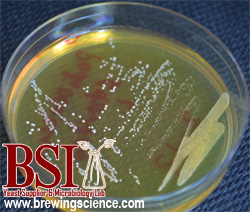Contamination Identification Techniques Using Media in Brewing
Contamination Identification Techniques Using Media in Brewing
In the world of brewing, the risk of contamination is always present, therefore identifying organisms is paramount. There are a few different medias that the brewing industry utilizes to assist in this endeavor. These include selective media, differential media, and universal media. Media can be liquid or solid, with both types providing a growing environment for microorganisms. The first step is to obtain a sample of the organisms in question, and smear or place a drop or two on the plate or in the liquid media. To promote growth of microorganisms, an incubator can be used, but it is not necessary. Growth of microorganisms varies, however, colonies can begin showing growth within two days, with some organisms taking longer. Identification of contamination via medias is possible when using several types of media in congress.
Selective Media Used in Brewing
Selective media is used to isolate select microorganisms by making it inhospitable for non-desirable organisms. There are a several selective medias that are used in brewing that allow for identification. These medias include Hsu’s Lactobacillus-Pediococcus media (HLPM) and Selective Medium for Megasphaera and Pectinatus (SMMP), Megasphaera and Pectinatus being known beer spoilers. HLPM detects Lactic Acid Bacteria (LAB) and will inhibit brewer’s yeast (Spedding, 2000, p.9). Lactobacillus and Pediococcus are the bacteria that grow in this media in brewing laboratories. HLPM is a fast and simple method to find spoilage bacteria. It’s easy to prepare and does not require sterilization of the media. SMMP inhibits brewing yeast due to the surplus of cycloheximide and growth of LAB is limited due to the alcohol content from the beer sample. These medias are excellent for identifying bacterial contamination.
Differential Media Used in Brewing
Differential media distinguishes microorganisms on agar based on their biochemical properties. In the brewing industry, differential medias such as Wallerstein Laboratories Nutrient Medium (WLN), Wallerstein Laboratories Differential Agar (WLD), MacConkey Agar, Lee’s Multi-Differential Agar (LMDA), Lysine medium (LYS), and Lin’s Copper Sulfate Medium (LCSM) are used. WLN media differentiates wild yeast, brewing yeast, and bacteria, and WLD isolates bacteria that is found in the brewing field

(WL Nutrient Medium, n.d, p. 1). The distinction between WLD and WLN is that WLD has added cycloheximide. The added cycloheximide allows for the suppression
of most yeast. MacConkey agar detects and isolates Enterobacteria as this media does not allow gram positive organisms to grow (Spedding, 2000, p.8). This is due to bile salts and crystal violet in the MacConkey Agar which inhibits the growth of gram positive organisms (MacConkey Agar, n.d.). In addition, the MacConkey agar also has a pH indicator which will turn growth pink in acidic conditions. LMDA assists in the identification of wild yeast and bacteria because brewing yeast is inhibited with this media due to cycloheximide. LMDA allows for the growth of bacteria seen in brewing laboratories such as Lactobacillus, Pediococcus, and Enterobacteria (Spedding, 2000, p. 8). Lysine Media contains lysine and helps distinguish Saccharomyces yeast from non-Saccharomyces yeast. Non-Saccharomyces yeast can grow in LYS media due to their ability
to tolerate lysine, unfortunately, for Saccharomyces yeast they cannot. LCSM detects non-Saccharomyces wild yeast as well as Saccharomyces wild yeast. In addition to detecting non-Saccharomyces and wild Saccharomyces, LCSM also inhibits bacterial growth.
Universal Media Used in Brewing
Universal media is a nutrient media that allows for growth of all microorganisms. The Universal Beer Agar (UBA) is an example of such media that detects microorganisms that are common in the brewing industry. This is because UBA enables growth of brewing yeast, wild yeast, bacteria, and mold. Incubation is not necessary; however, it helps speed up the results. These medias are used all throughout the brewing world to help identify contaminates. BSI provides clients with UBA and LMDA agar plates upon request. Let BSI help in contamination identification and brewing top quality beer.
BSI sells UBA and LMDA that you can order today!
References
MacConkey Agar. MacConkey Agar | Summary of Biochemical Tests | Additional Info | Molb 2021 | College of Agriculture and Natural Sciences. (n.d.). Retrieved January 15, 2023, from http://www.uwyo.edu/molb2021/additional_info/summ_biochem/macconkey.html
Spedding, G. (2000). Microbiological Media for Bacteria and Wild Yeast Detection in the Brewery. Retrieved January 15, 2023.
WL Nutrient Medium • WL Nutrient Broth WL Differential Medium. (n.d.).
By LeeAnna Henley, BSI Microtechnologist

